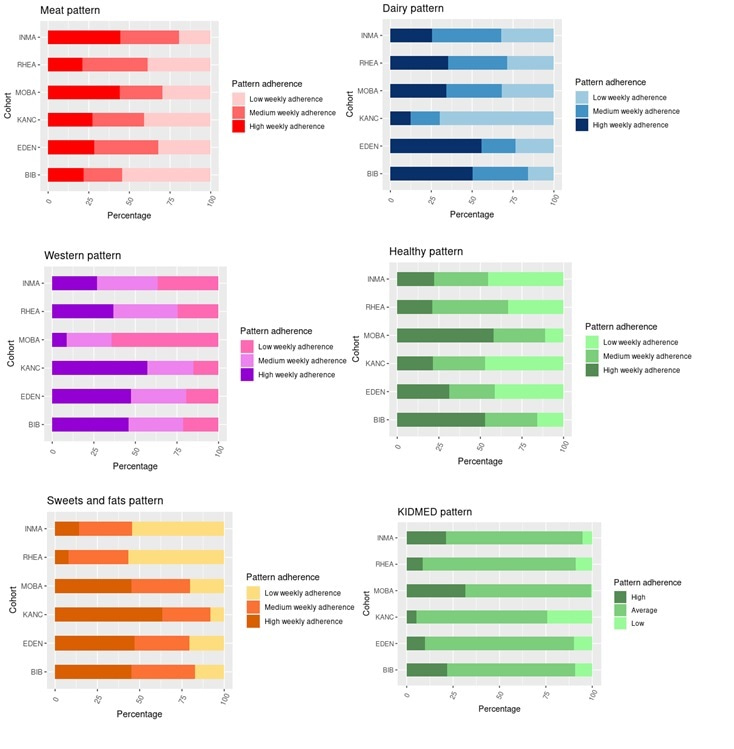Dietary patterns among European children and their association with adiposity-related outcomes
Published in Healthcare & Nursing, General & Internal Medicine, and Public Health
Overview
Overweight and obesity rates in childhood and adolescence have plateaued in many high-inome countries in the lst decades, however levels are still concerningly high, with almost one out of three 5-9-year-old children with excess weight - it is estimated that 29% of children have overweight/obesity in Europe1.
Since overweight and obesity is a complex and multifactorial condition, many factors play a role in its development. One of these factors is diet - which has been changing substantially in the past decades. Globalization and urbanization may be behind this shift, in which traditional diets, sich as Mediterranean diet, loose space for highly processed diets2. The investigation of child diet is of special interest due to their influence on diet-related diseases during childhood (e.g., obesity)3 and the tracking of dietary habits across the lifespan4.
In epidemiological studies, it is possible to derive deitary patterns using a prior indices (such as the Mediterranean dietary pattern) and a posteriori methods, using available dietary data. To the best of our knowledge, no study has described data-driven and a priori dietary patterns in children across different European countries or explored the association between these patterns and adiposity-related outcomes prospectively. To address this gap, we derived both data-driven and a priori dietary patterns at primary school-age and examined their association with adiposity-related outcomes both cross-sectionally in childhood and prospectively in adolescence across population-based cohorts from each part of Europe.
Methods & Results
This study used data of six cohorts in Europe (UK (BiB), France (EDEN), Spain (INMA), Lithuania (KANC), Norway (MoBa) and Greece (RHEA) - Figure 1), when children were 6-11 years-old and in the second follow-up, when children were between 12-18 years-old.

Figure 1. Cohorts participating in HELIX. The HELIX subcohort includes a subsample of BiB, EDEN, INMA, KANC, MoBa, and RHEA cohorts.
Information on dietary intake was measured through a food frequency questionnaire in school-age, in which parents responded on child`s habitual diet - 44 food items were grouped in 15 food groups. We derived one a priori patter (KIDMED), and five distinct data-driven dietary patterns, characterized by the greater consumption of different food items: “Meat pattern”, with meat and processed meat products, “Dairy pattern”, with yogurt and dairy products, “Western pattern”, with sweets, beverages, potatoes and bakery products, “Healthy pattern”, with vegetables, fruits and fish, and “Sweets and fats pattern”, with sweets, oil and fats (butter and margarine). As shown in Figure 2, almost 58% of children in MoBa (Norway) reported high “Healthy pattern” adherence. On the other hand, children from RHEA (Greece), INMA (Spain) and KANC (Lithuania) had the lowest percentages of high adherence to the “Healthy pattern” . Only 18.2% of children had high adherence on the KIDMED index, ranging from 31.7% in Norway to 5.4% in Lithuania.

Figure 2. Dietary patterns description and respective adherence within all six cohorts.
Child and adolescent height and weight were measured in each visit, participants` sex- and age-standardized body mass index (zBMI) was calculated and categorized as having underweight/healthy weight or overweight/obesity. In addition, other adiposity-related outcomes were included in this study, such as waist-to-height ratio (i.e., waist circumference/height) and fat mass proportion (in %, estimated through bioimpedance).
Children with lower intake of of healthy foods (vegetables, fruits, fish) tended to have higher adiposity, e.g., children with average or low “Healthy pattern” adherence (vs. high) had higher fat mass proportion in childhood. Low adherence to a “Healthy pattern” (vs. high) was associated with increased adolescent zBMI, and child and adolescent waist-to-height ratio. Low “Dairy pattern” adherence (vs. high), was associated with lower zBMI and fat mass in childhood, but not in adolescence. No significant associations were seen with the KIDMED index.
Conclusions
Obtaining high quality data to strengthen the evidence for an association between child diet and adiposity related outcomes is challenging. Diet is notoriously difficult to measure and largely dependent on self-reports and parental factors. Still, this study shows that many European children have poor diets, and that poor adherence to a healthy diet pattern was associated with adiposity, particularly higher fat mass proportion and higher waist-to-height ratio.
References
1. World Health Organization (WHO). Regional Office for Europe. WHO European Childhood Obesity Surveillance Initiative (COSI): Report on the fifth round of data collection, 2018–2020 [Internet]. 2022. p. 70. Available from: https://www.who.int/europe/publications/i/item/WHO-EURO-2022-6594-46360-67071
2. Moreno L, Sarría A, Popkin B. The nutrition transition in Spain: a European Mediterranean country. European Journal of Clinical Nutrition. 2002 Oct 24;56(10):992–1003.
3. Sharma V, Coleman S, Nixon J, Sharples L, Hamilton‐Shield J, Rutter H, et al. A systematic review and meta‐analysis estimating the population prevalence of comorbidities in children and adolescents aged 5 to 18 years. Obesity Reviews. 2019 Oct 24;20(10):1341–9.
4. Hovdenak IM, Stea TH, Twisk J, te Velde SJ, Klepp KI, Bere E. Tracking of fruit, vegetables and unhealthy snacks consumption from childhood to adulthood (15 year period): does exposure to a free school fruit programme modify the observed tracking? International Journal of Behavioral Nutrition and Physical Activity. 2019 Dec 15;16(1):22.
Follow the Topic
-
International Journal of Obesity

This is a multi-disciplinary forum for research describing basic, clinical and applied studies in biochemistry, physiology, genetics and nutrition, molecular, metabolic, psychological and epidemiological aspects of obesity and related disorders.




Please sign in or register for FREE
If you are a registered user on Research Communities by Springer Nature, please sign in